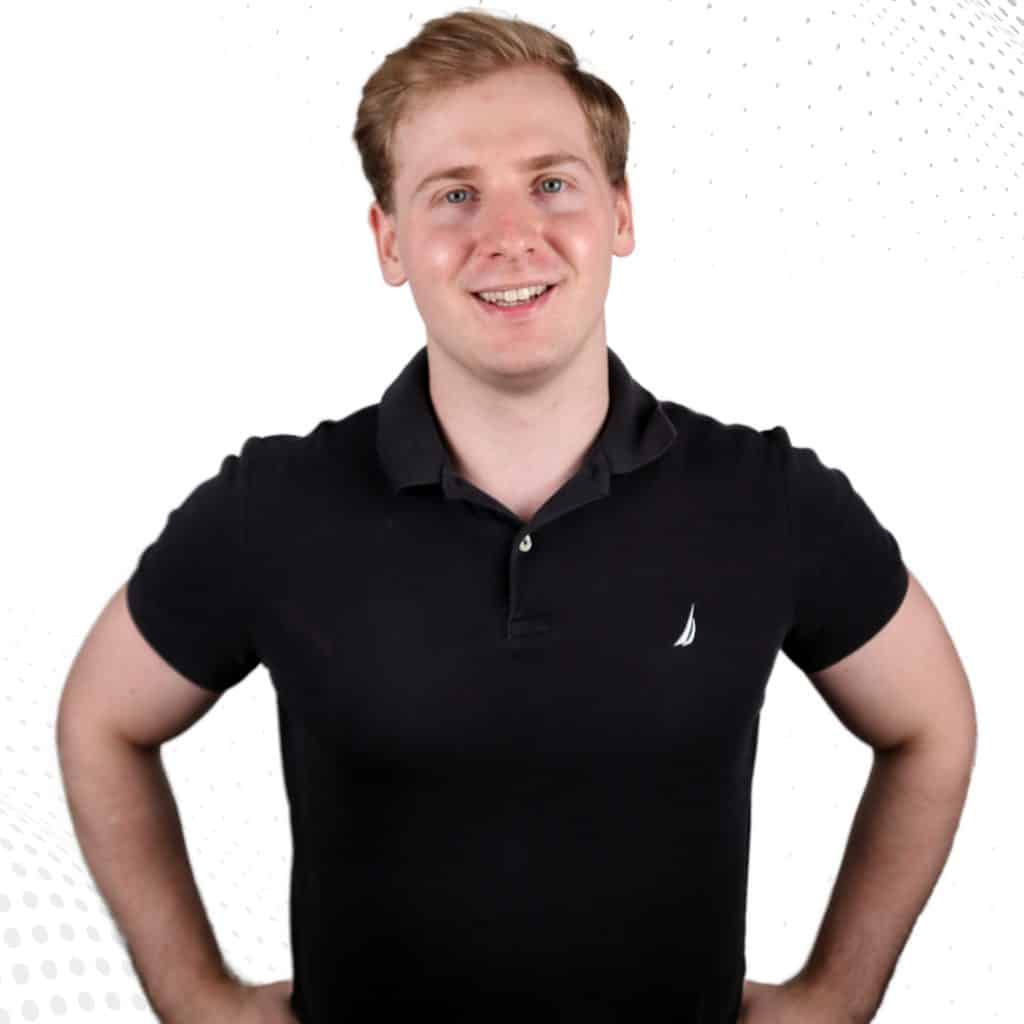Are you looking for ways to monetize your lead generation efforts or skills?
Selling leads can be a highly profitable business model, especially if you have a knack for generating high-quality leads.
In this blog post, we will explore how to sell leads and different ways to sell leads to businesses or brokers to maximize your profits.
With that, let’s start with how to sell leads with this detailed 10-step process:
Step #1: Find Your Niche
The first step in selling leads is to identify your niche. A niche is a specific area or industry that you will focus on when generating leads for the business which could virtually be any industry where a business needs to generate leads such as real estate, finance, healthcare, marketing, technology, and many local businesses such as plumbers, electrician, painters, etc.
You also need to decide on your lead targeting, whether you want to generate leads from a local area or internationally as each of these has its pros and cons:
- Locally: When targeting leads locally, you are focusing on a specific geographic region or area. Often, it’s much easier and cheaper to target local areas for lead generation, but the lead generation demand is typically very low.
- Internationally: When targeting leads internationally, you are casting a wider net and essentially, you can generate an almost unlimited number of leads, but it’s typically much harder and more expensive to compete internationally, plus you need to consider any local laws and regulations.
Niche selection is essential for selling leads as it will determine whether you are targeting B2C or B2B Target audiences, what strategies you will use, how much it can cost you, and your overall chances of succeeding with selling leads.
So, if you are doing this for the first time, it’s important that you select a niche you are familiar with, understand the buyers, have good knowledge of the industry and it has low competition, as all this will help you generate and sell leads.
Step #2: Analyze Your Competitors
Once you have identified your niche the next step is to analyze your competitors. This will involve studying and researching the businesses already operating in your niche to understand your chances of competing in that niche.
Because, before you start creating a website and investing in lead generation, you need to decide how hard it will be to penetrate the industry and area.
And to do that, it’s important to use a range of tools and methods to comprehensively understand how tough the competition is. Three key approaches are SEO competitor analysis, competitor backlink analysis, and Local SEO Competitive Analysis.
SEO Competitor analysis will tell you how hard will be to outrank your competitors as you can study their website authority, organic traffic, ranking keywords, and content. For this, you can use tools like SE Ranking.
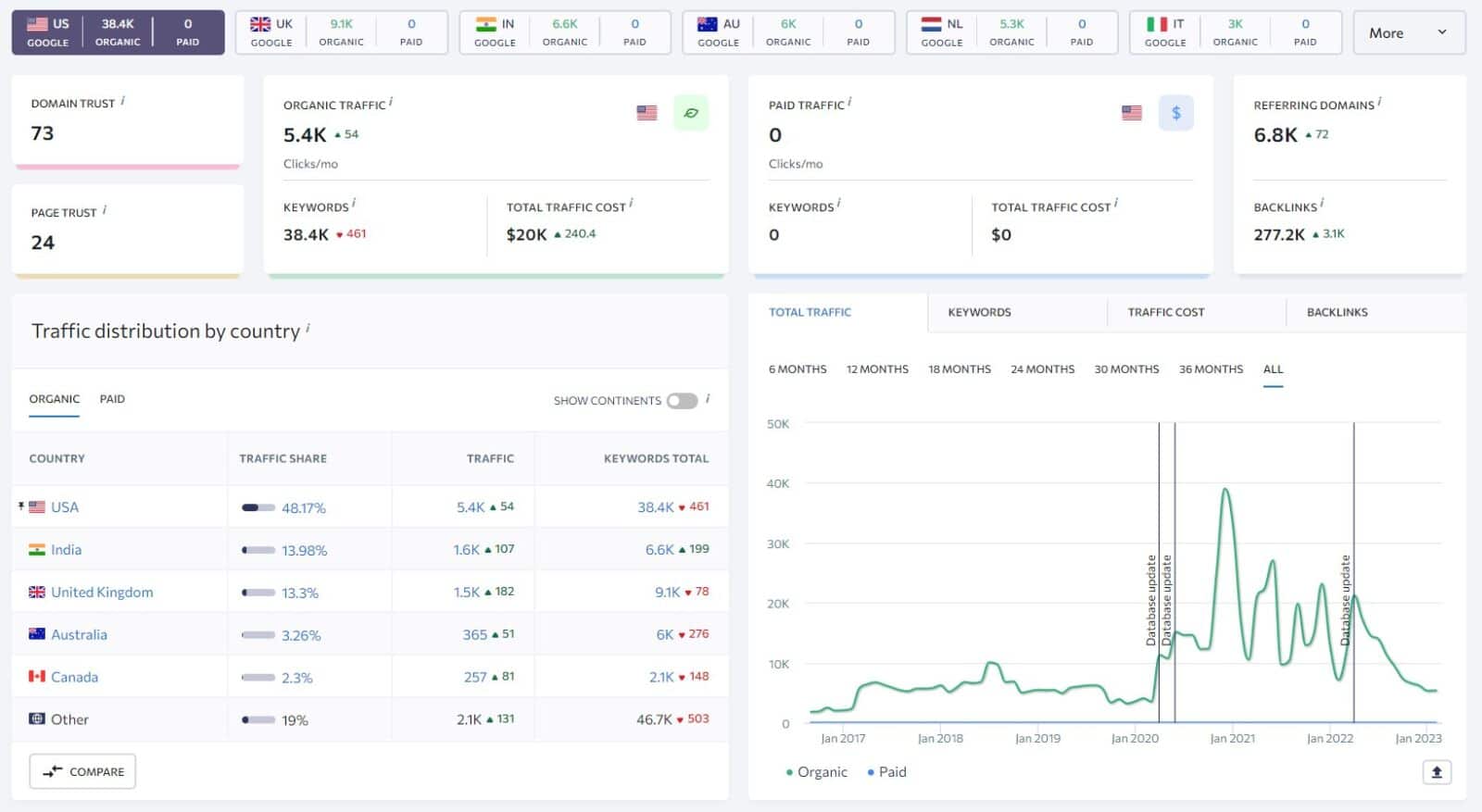
While competitor backlink analysis will tell you how many backlinks and referring domains you will need to build for your website and content in order to compete in SERPs (search engine result pages) for your target keywords.
Obviously, the more backlinks and referring domains you need to build the more expensive it will be to compete. Again, you can use SE Ranking to do this.
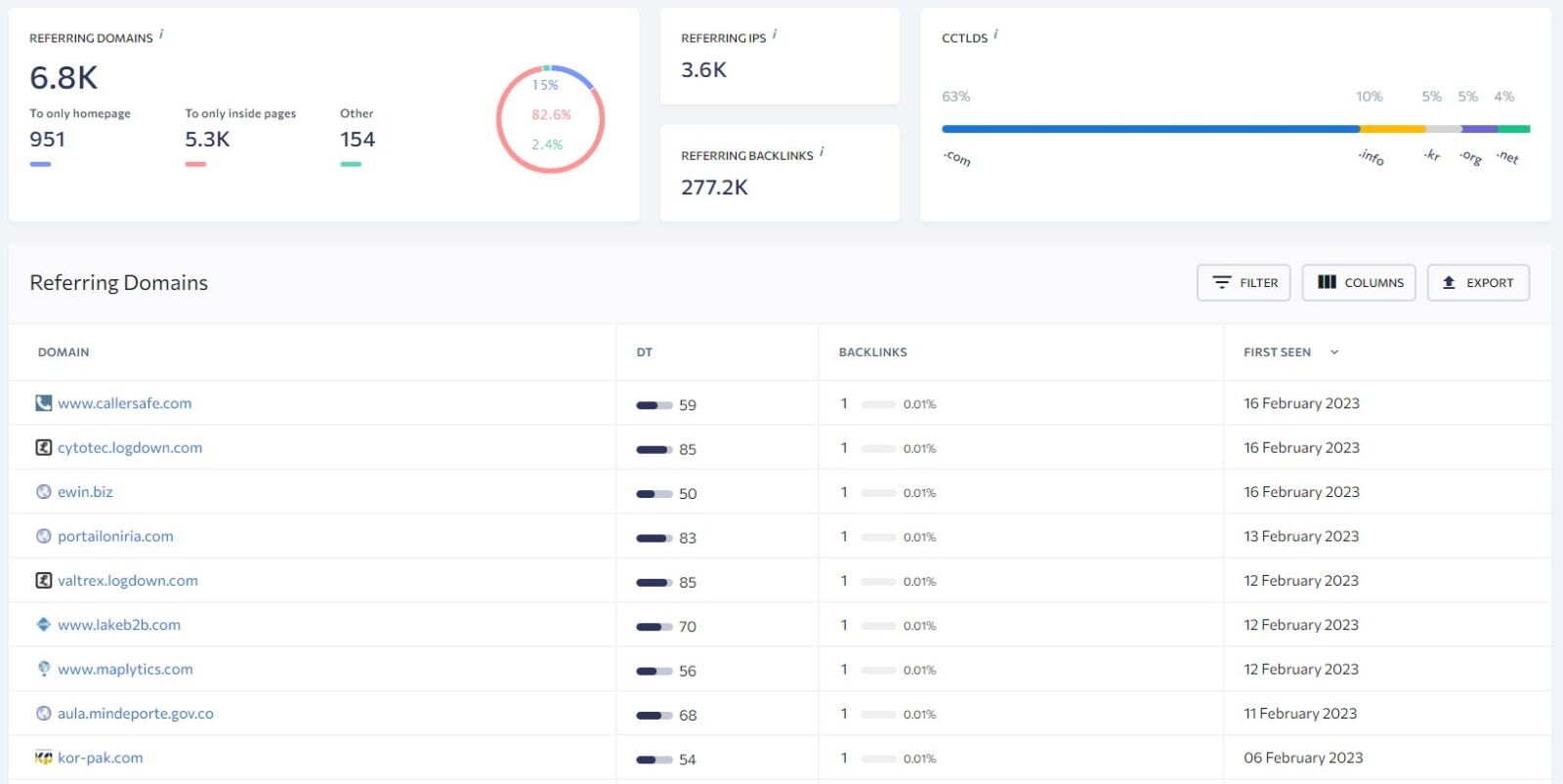
So, before you start doing anything, make sure you understand the competition. This applies in both cases whether you are targeting locally or internationally.
You also want to analyze the website and the business itself, such as what is the website design, how long they’ve been in business, what is their customer base, etc.
All this will further help you decide if you want to proceed with your selected niche and if so, who you will be targeting.
Step #3: Create Lead Generation Plan
Once you have identified your niche and analyzed your potential competitors and you are feeling confident you can do better than them, the next step in how to sell leads is to create a lead generation plan.
There are numerous lead generation strategies that you use to generate leads, but here are the four most common that probably you will use when selling leads:
- Advertising: Just like any business, you can start with advertising. Currently, the most cost-effective method is Google advertising but depending on your business you can advertise on social media as well. This method is very easy and fast to do but goes into your profit margins.
- Cold Email: You can also purchase an email list or create your own email list using tools such as Tomba or Hunter to reach potential leads. However, it can generate poor-quality leads and it can be expensive.
- SEO: With SEO lead generation, you can generate high-quality B2C or B2B sales leads day and night with a very high-profit margin when selling leads, but it can take a very long time before you see any results or if the competitor is too big, you may never see any results.
- Create an Email List: You also want to create your own email list with potential customers that are not ready to buy. With a proper email marketing strategy and lead nurturing strategy you can increase the number of leads at a very high ROI.
- Buy Leads: Lastly, you can act as a middle person and purchase leads from somebody and resell them to businesses. This can be a very easy method, but with a very low-profit margin for you and it cannot be applied to every industry.
When you are creating your lead generation plan, you must consider the cost of generating leads as well as how much you can sell the leads to businesses in order to become a profitable business.
Of course, your lead generation plan should have a mix of different strategies to maximize your lead generation potential. I recommend finding a niche, where you can do SEO lead generation as that will allow you to generate the most profit.
Also, if you are bold, then start with PPC advertising as you can virtually generate leads in a matter of days.
If you are targeting a B2B target audience and need to generate B2B sales leads, then I recommend you check out my article on B2B lead generation strategies to get more ideas.
Step #4: Create Lead Pricing
The next step after you have prepared your lead generation strategies is to create lead pricing.
Now, there are different types of business models for selling leads, but the best way is to calculate the cost per lead and based on that you can establish your pricing.
With that, to calculate how much you should charge per one lead you will need to collect:
- Average Cost-per-Click is the amount you pay each time someone clicks on your ad.
- Average Conversion Rate is the percentage of people who take a desired action after clicking on your ad, such as filling out a form or making a purchase.
- Average Cost Per Lead is the cost of how much you pay to generate a lead.
For example, let’s say I want to generate plumbing leads for local businesses in Richmond, Virginia.
So, to calculate the average CPC for relevant keywords in your target niche/industry, you can use Google Keyword Planner, where you can select the exact target location.

Then you can enter relevant broad keywords or better, enter one of your competitor’s websites to find relevant keywords.
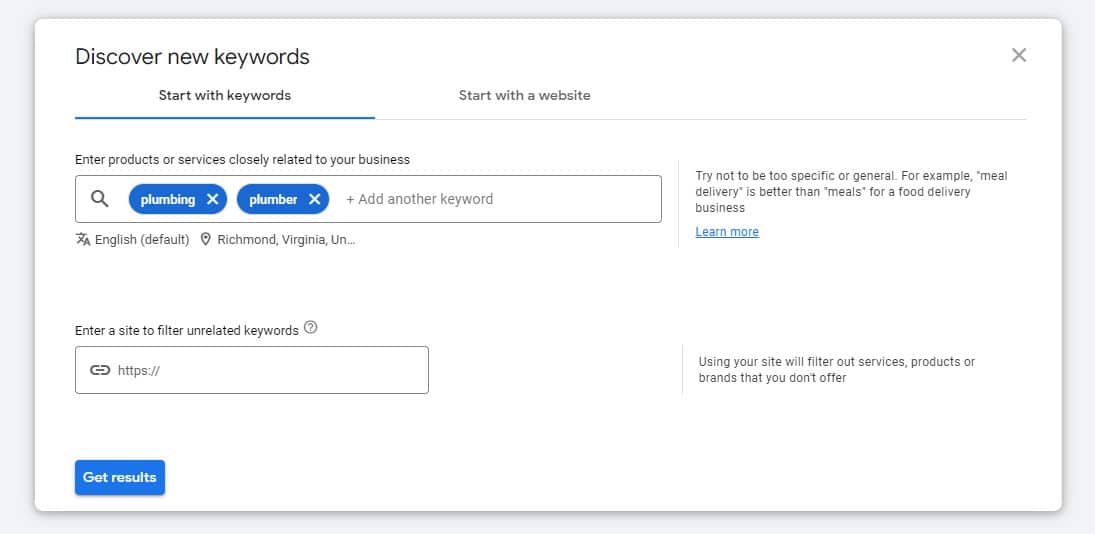
And here you will get a ton of relevant, commercial keywords and transactional keywords to your target industry, as well as other ideas so you can calculate the average CPC.

Let’s say that the average CPC for a plumbing business in Richmond, Virginia is US$1.20.
Then we will need the average conversion rate. A quick Google search showed me that the average conversion rate is 2.87% and also give me other data that I can use or calculate myself.
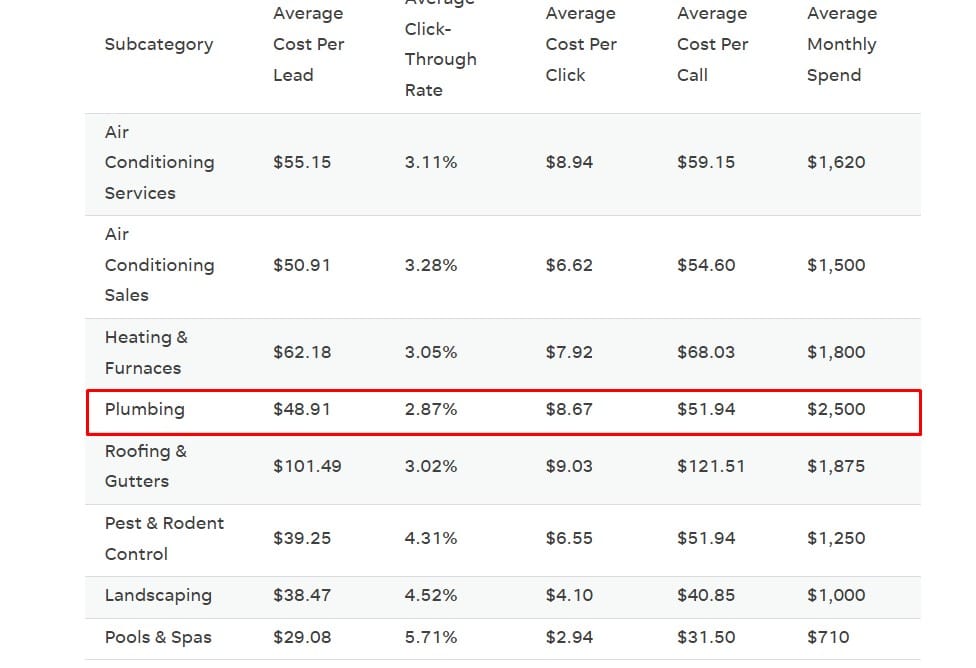
Now, to calculate the average CPL you can use the data provided or calculate it yourself using the following formulas.
- Formular #1: Total Spend = Total Number of Clicks x Average CPC. Let’s assume that the total number of clicks is 1,000 for easy math. So, in my case, it would be (1,000 x 1.2 = 1,200) BTW, I am using CPC I have found, not from the graph above.
- Formula #2: Number of Leads = Total Number of Clicks / Average Conversation Rate. In my case it would be (1,000 x 2.87% = 28.7, round it to 29 leads)
- Formula #3: Average Cost per Lead = Total Spend / Number of Leads. So, in my case, it would be (1,200/29=41.3)

Based on these formulas, I can assume that the average cost per lead would be US$41.3
However, keep in mind that you’ll need to add your own profit margin to make a profit from selling the leads. Depending on the industry, profit margins can vary between 10-20%. This means that you may need to sell each lead for $45-$50 in order to turn a profit.
You can start with 15% and then based on demand and lead quality you can adjust.
Additionally, by combining SEO with PPC and other lead generation strategies, you will be able to drive the CPL down, resulting in higher profit margins or being able to drop the price to become more competitive.
That’s why it’s important that you have multiple lead sources to maximize your revenue from selling leads to businesses.
PPC Advice: There are always a few very high-converting keywords with a conversation rate higher than 10%, but with high CPC, but then many very bad converting keywords with very low CPC. Therefore, calculating the average CPL can be difficult without having real data.
So based on this, I also recommend checking how much the business usually makes providing services. For example, for plumbing businesses, it can be somewhere around $200-$500.
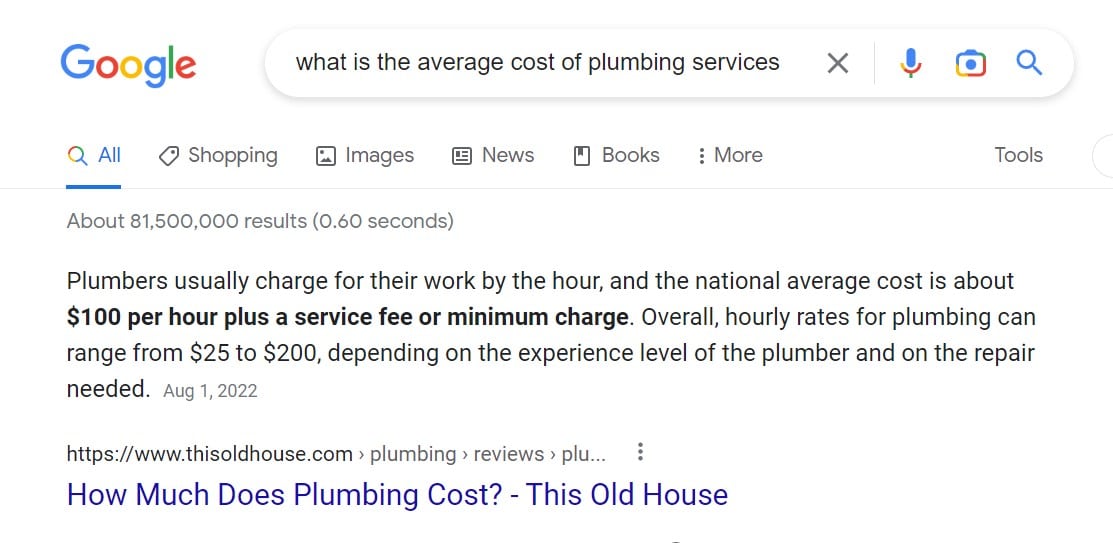
And in some industries, such as in SaaS or even eCommerce, businesses are willing to spend more for leads than they actually make from the purchase as they are looking at the total lifetime value of a customer.
Step #5: Conduct Keyword Research
Once you know how much you can sell leads, then you need to start preparing your keyword research plan to create an SEO strategy or B2B SEO Strategy.
As I said, by combining SEO with PPC and other lead generation strategies, you will be able to drive the cost per lead lower resulting in better profit margins or being more competitive.
With that, there are various keyword research techniques you can apply to find important informational keywords, commercial keywords, transactional keywords, and profitable keywords.
Here are a few of my favorite, yet easy keyword research techniques:
Technique #1: Using Seed Keyword.
Just take one of the closely relevant, yet broader (not too broad) keywords from your target industry or niche, toss it in a keyword research tool such as SE Ranking, and select your target location.
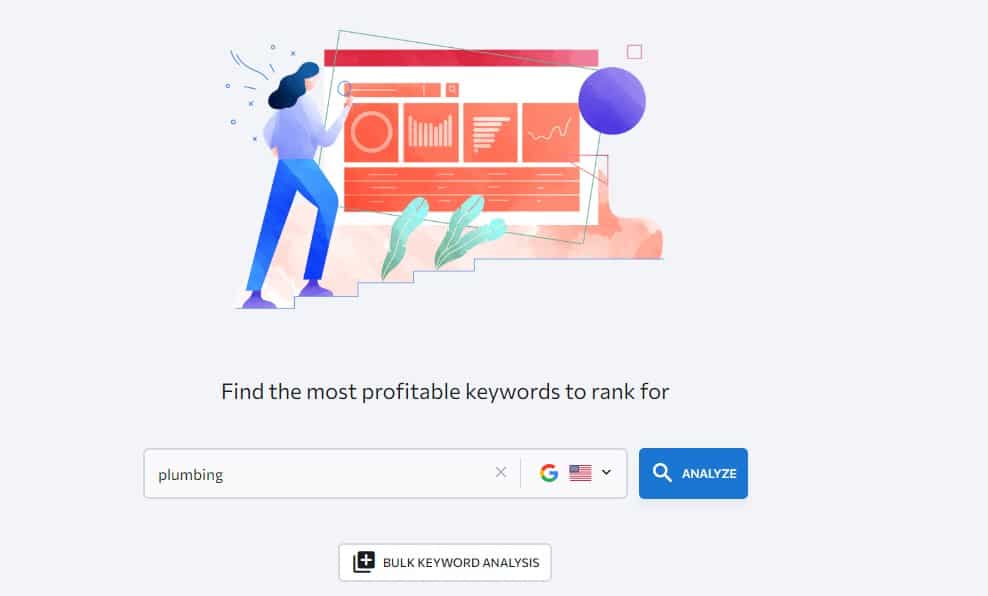
And then in the Keyword Suggestion Report, you would find all relevant primary and secondary keywords to your niche across all stages of the SEO funnel.
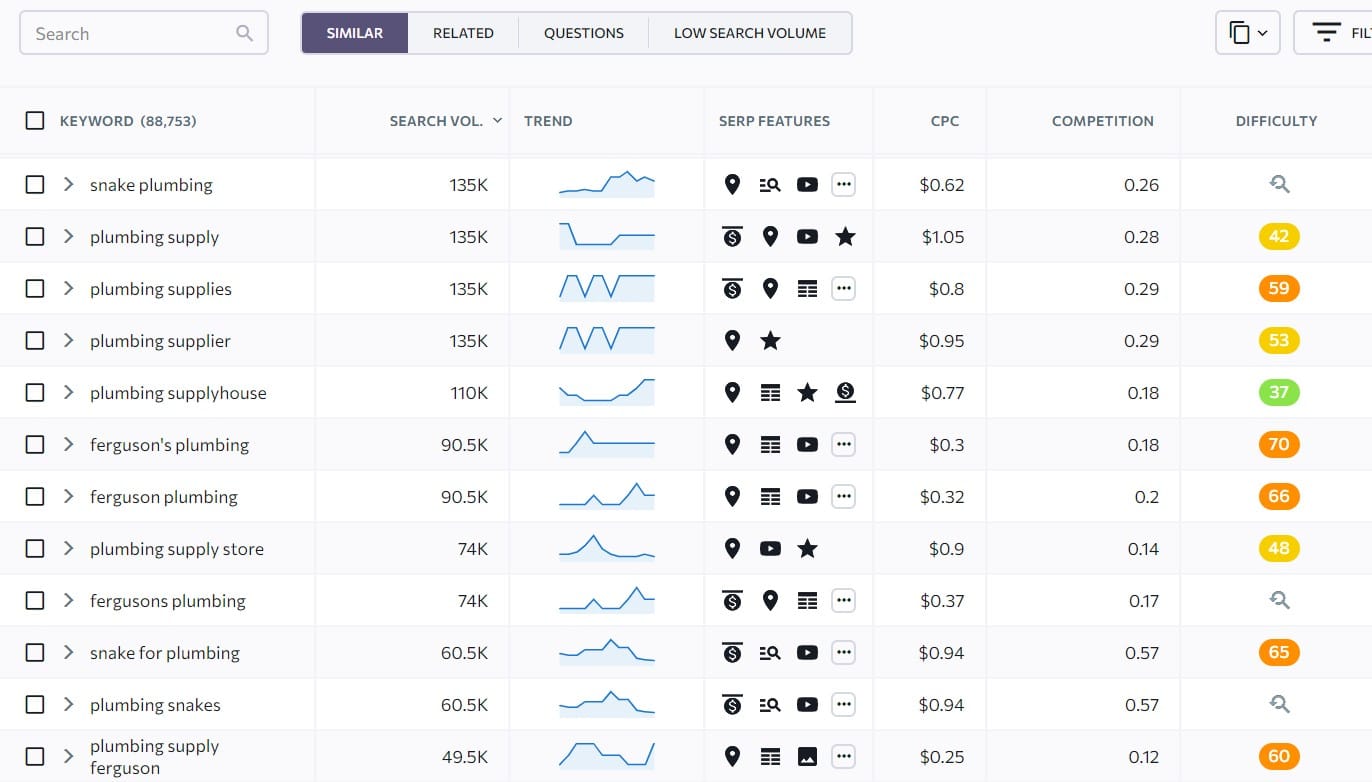
Technique #2: Competitor Analysis.
Analyzing close competitors is an excellent way to find relevant keywords. For example, a website targeting plumbing keywords in Richmond is Project Plumbing Inc.
So, with SE Ranking, I can analyze their website and check what keywords they are ranking for.
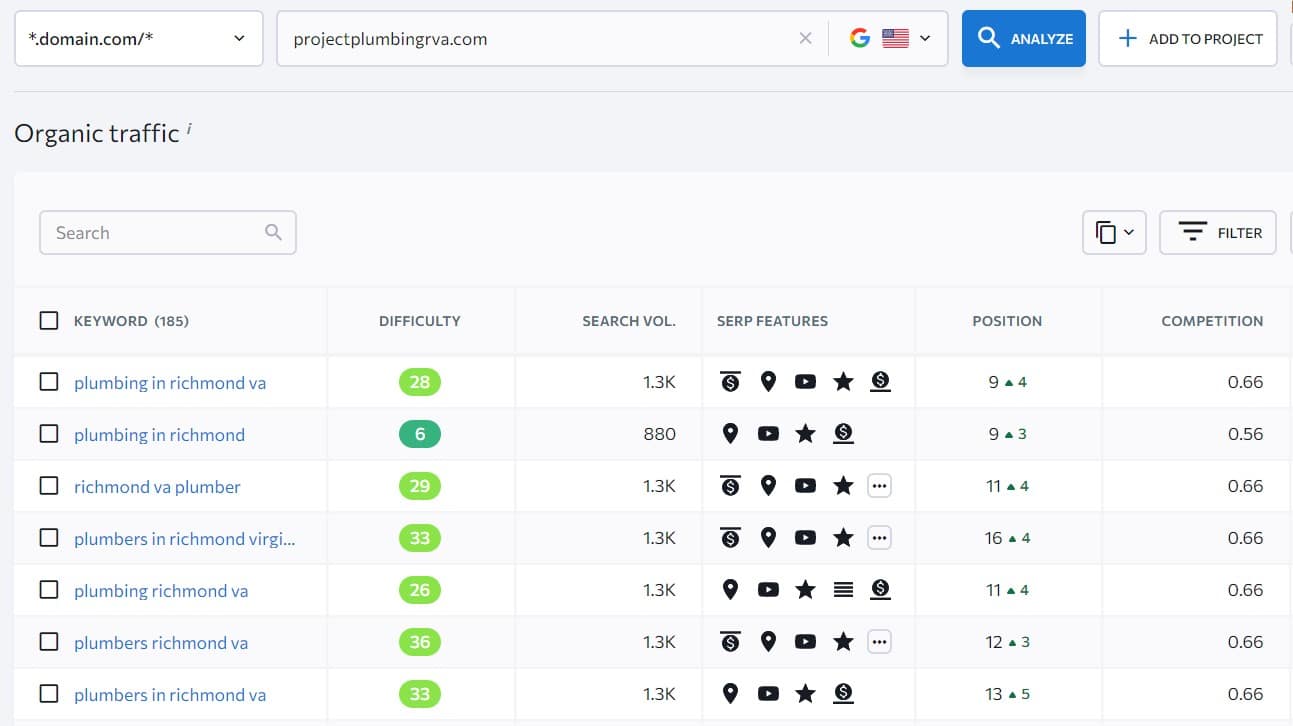
Technique #3: Google Search
The last technique is you can use Google Search to find relevant keywords if you don’t want to spend money on SEO tools or B2B SEO tools.
Just enter one of your seed keywords into Google search and check all the suggestions Google gives you such as the People Also Ask (PAA) box.
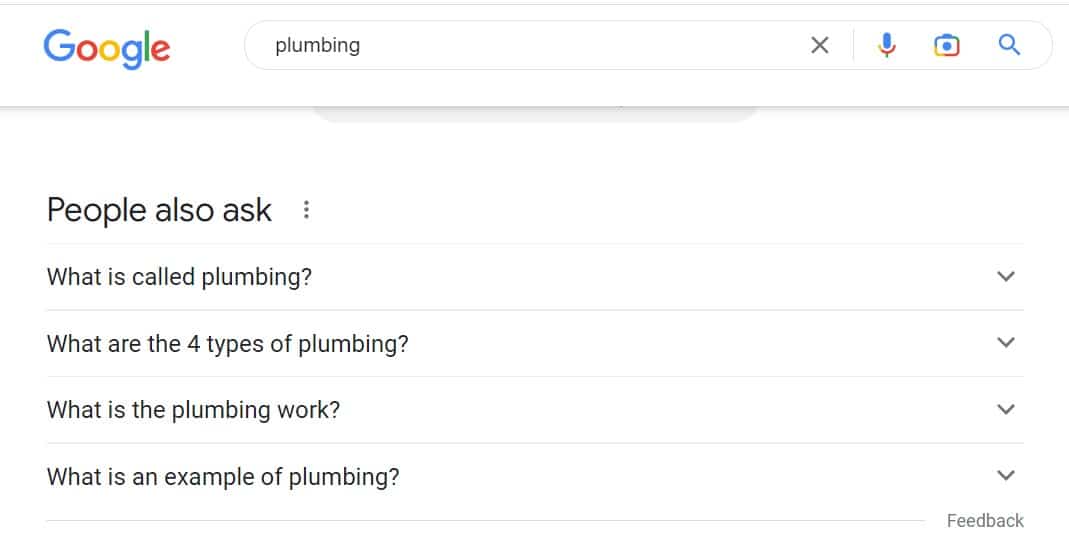
Or at the bottom, Google provides related searches.

And just clicking through these and going deeper in the rabbit hole you will find more relevant SEO keywords that you can target.
And of course, there are more techniques you can use as well as free keyword research tools.
Also, to learn more, check out my keyword research guides as well as the links mentioned above:
- Long-Tail Keywords: 8 Unique Techniques to Find Them
- Primary Keywords: The Guide to Target Main Keywords in SEO
- How Do I Find SEO Keywords? 11 Best Techniques
- Content Gap Analysis: The Ultimate Guide (2023)
Step #6: Start Creating SEO Content
The next step in your SEO strategy to start generating leads and subsequently being able to sell leads is to start creating SEO-friendly Content on your website.
Creating SEO-friendly content involves several best practices to ensure that your website pages are optimized for both search engines and your target audience.
Here are some key SEO content best practices to consider when creating SEO content:
- Develop high-quality content that provides value to your target audience. This includes creating unique and engaging content that answers their questions and solves their problems.
- Optimize your content for keyword placement to help search engines understand the context of your content and improve your website’s ranking in search results.
- Establish a proper internal linking structure by linking to relevant pages within your website. This helps search engines understand the hierarchy of your website, improve crawling, and ranking, and improve the user experience for your visitors.
- Create SEO-friendly headlines that accurately reflect the content of your page and include your target keywords.
- Create SEO-friendly URLs that are short, descriptive, and easy to read. This helps search engines understand the content of your page and improves the user experience for your visitors. I recommend only using primary keywords in your URLs.
- Use external links in your blogs to authoritative sources. This helps search engines understand the context of your content and improves your website’s credibility.
- Use SEO-friendly images that are optimized for search engines by using descriptive file names and alt tags, load fast, and improve user understanding of the context.
- Avoid using only AI-generated content as it may not provide the depth and value that human-generated content can provide, plus Google can penalize it. Use it as your assistant.
When it comes to your SEO content, you must ensure, that your on-page SEO and technical SEO are on point to improve your website’s visibility in search results, attract more traffic to your site, and ultimately generate more leads for your business.
If you want to learn more about on-page SEO, check out these articles:
- How to Add Keywords in WordPress? [Guide for Beginners]
- In SEO How Many Keywords per Page? [Proper Answer]
- Blog SEO: Best Tips & Practices to Get You Started
Step #7: Create Product/Service Pages
The next step in selling leads is to also create your product and/or service pages on your website so your website visitors know, you are selling services or products, have ways to contact you, and ultimately drive users at BOFU (bottom of the funnel) stage to your website to generate the highest quality leads.
With that here are some of the best practices for product page SEO and service page SEO to rank your pages and have high conversions:
- Perfect Your on-page SEO by optimizing your title tags, meta descriptions, and header tags to accurately describe your products or services and include relevant keywords.
- Perfect your technical SEO by ensuring that your website is fast, mobile-friendly, and easily crawlable by search engines.
- Optimize your above-the-fold content to provide a clear and concise overview of your product or service, including key features, benefits, and pricing.
- Create creative and action-oriented CTAs that encourage potential customers to take action, such as “Remove Bed Bugs Now” or “Schedule a Consultation.”
- Focus on solving problems for your customers by highlighting how your product or service can address their pain points and improve their lives or businesses.
- Use custom images that accurately represent your product or service and provide visual interest for your potential customers as well as an explanation of how your service/product works.
- Implement the right schema markup to help search engines understand the context of your content and improve your website’s visibility in search results.
- Have a lead-generation-centric UX design that follows landing page and product page templates specific to your industry. This will improve the user experience for your potential customers and increase the chances of generating high-quality leads.
By following these best practices for product page SEO and service page SEO, you can improve the ranking of your pages in search results, increase traffic to your website, and ultimately generate more high-quality leads for your business.
Additionally, when you are creating product or service pages on your website one of the main aspects apart from the above-mentioned, is to ensure your page speed is fast.
Researches show website conversion rates drop by an average of 4.42% with each additional second of load time and 82% of consumers say slow page speeds impact their purchasing decisions.
Step #8: Build High-Quality Backlinks
After creating your product/service pages as well as a couple of informational blog posts, then you can slowly start building high-quality backlinks for your website.
Link Building benefits are enormous and plainly said, it’s very hard to rank without building at least a couple of backlinks to your website.
I recommend you start with easy link building strategies such as HARO link building, guest posting, resource page link building, and link insertion as they are beginner friendly, yet very effective.
Definitely check out my guides to learn more about link building strategies.
However, what I want to share with you is on what sites you should build backlinks to avoid being penalized, get the best results, and have the highest acceptance rate.
- First of all, you want to build backlinks on websites with at least 500-1,000 organic traffic according to an SEO tool such as SE Ranking. The reason for that is that organic traffic is a good indication that the website is trusted by Google.
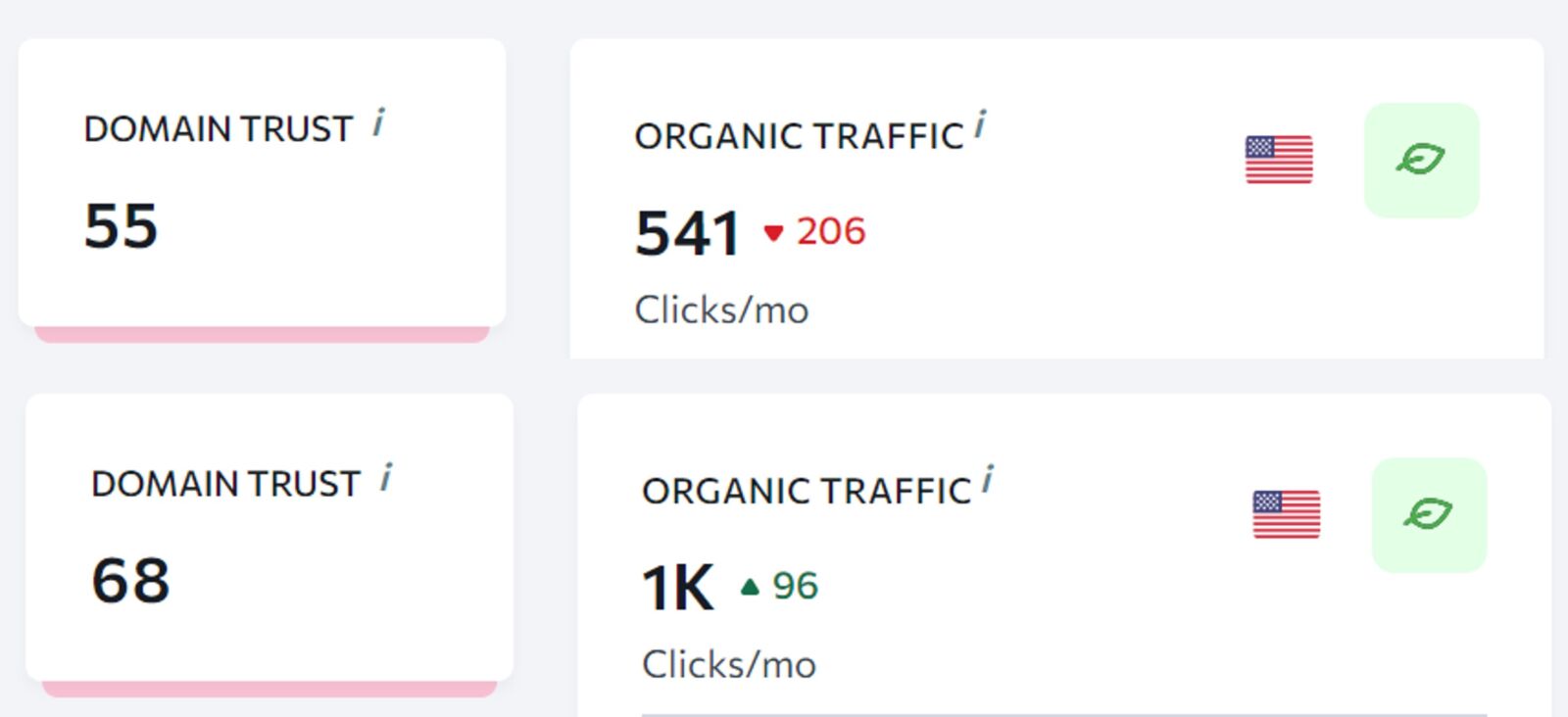
- Secondly, focus on building backlinks from a website that drives most of its organic traffic from your target country, as it will improve your ranking in that region.

- Thirdly, build backlinks on a website with similar website authority with +/-10. For example, if you are a website with a Domain Trust of 50, then you can build backlinks on websites with a domain trust between 40-60.

- Lastly, don’t over-optimize your anchor text as it is a sure way to get penalized. Follow the anchor text ratio.
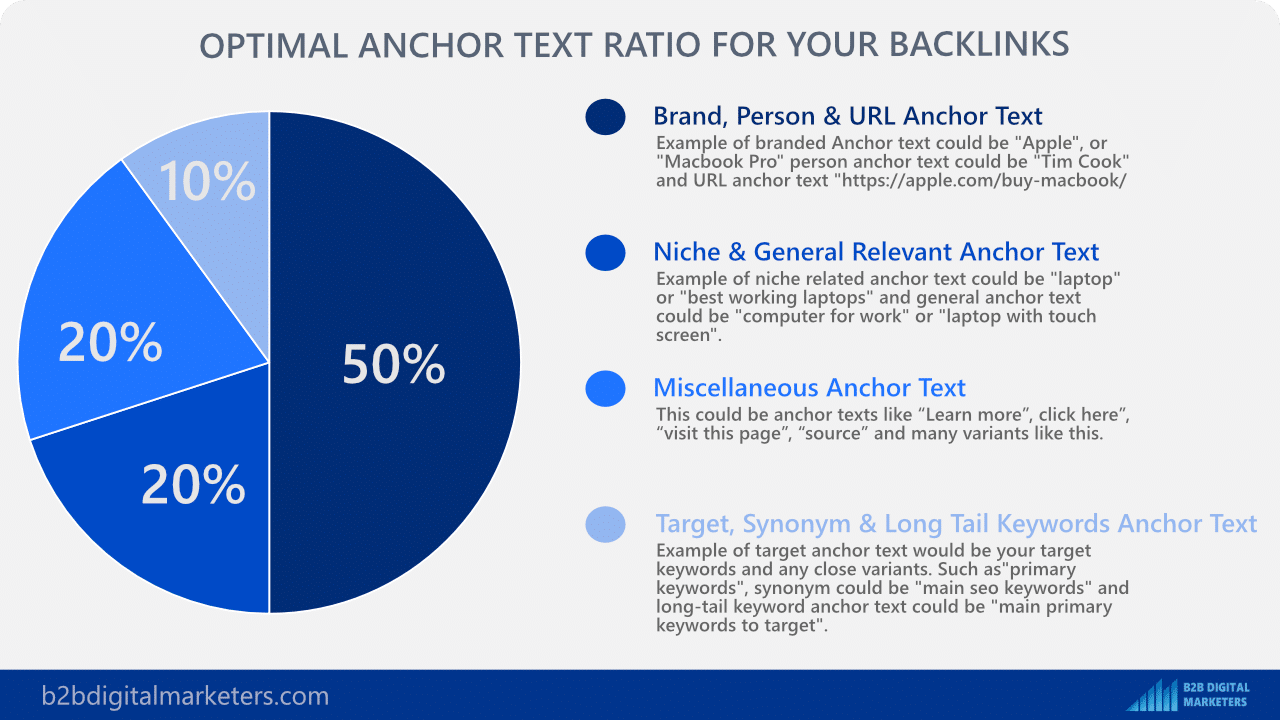
But of course, also don’t forget to implement other parts of Off-page SEO such as citation building, collecting reviews, or business listing, especially if you are focusing on the local area as it will help you rank better for local keywords and drive local clients.
Step #9: Create a Brokers List
The ninth step of how to sell leads is to create your broker’s list or potential list of businesses that would be interested in your leads.
When it comes to creating a brokers list, there are two ways how you can sell your leads:
- Directly to Businesses: These are the businesses that are actually selling the products or services to companies directly. With these consider factors like company size, location, and purchasing behavior when identifying potential buyers of your leads. The benefit is that you will get good prices for selling directly to businesses. But the downside of it is you have to deal with them, which can be challenging.
- Middleman Brokers: These businesses are just like you, focusing on lead generation and selling leads to businesses. Well, establish marketing brands are happy to purchase leads from you and resell them to their customers. The benefit of it is you don’t need to search for customers as well as deal with them. The downside is you get less profit.

I highly recommend having both options of selling leads directly to businesses and through middleman brokers.
This way, if you generate an excess of leads and your partner refuses them as they are at full capacity, you have a backup plan. Instead of discarding these leads, you can resell them to a marketing agency or another middleman broker who can help you find new buyers for your leads.
By having multiple options available, you can maximize your profits and avoid missing out on potential sales opportunities.
When it comes to finding brokers, there are various methods that you can use. Two popular options include:
- Search Engines: You can use search engines like Google to look for companies that operate in your target industry and actually provide the services or products. You can also search for brokers who specialize in lead generation for your target industry or niche. For example, if you sell plumbing leads, then you can find plumbing companies in your area or marketing agencies/brokers specializing in marketing for plumbing businesses.
- Social Media: Social media platforms like LinkedIn can be a great way to find potential brokers. By searching for brokers or businesses that operate in your target industry, you can connect with individuals who might be interested in buying your leads. You can also use social media to promote your leads and attract potential buyers.
With that creating a broker’s list is essential, yet the easy part of selling leads as many businesses need leads, but only a few of them are having the skills to do lead generation themselves.
Step #10: Distribute Your Leads
And the very last step of how to sell leads is how you can distribute your leads to those businesses or brokers you have struck deals with.
There are several ways how you can distribute your leads to businesses or brokers, but probably the three most commonly used are:
- Email the incoming leads: Most lead forms allow you to send a notification to an email address every time you receive a lead. You can easily configure it to email the notification to both you and the business or broker in real time. As you know, the sooner you respond, the higher your chances of closing the deal before your competitors.
- Call Tracking Solution: It’s also a good idea to use a call tracking solution that allows you to redirect calls to the right person in the business or lead generation agency. This is important to ensure that you can provide a call option on your website, which can generate high-quality leads without losing them.
- Post it in CRM: More established companies may have a CRM where you can manually or automatically post the lead, depending on the solution.
Of course, there are more ways to distribute your leads, such as using a lead management platform or lead distribution software.
These tools can help you automate the process of distributing leads, ensuring that they are sent to the right businesses or brokers promptly.
They can also provide you with analytics and reports on how your leads are performing, which can help you optimize your lead generation strategy.
However, it’s important to remember that the way you distribute your leads can have a significant impact on your sales and customer satisfaction. So, make sure you work with the businesses or brokers you’re partnering with to understand their preferences and needs when it comes to receiving leads.
5 Business Models of Selling Leads
As said, selling leads can be a lucrative business model with very little capital needed to start functioning. Because of that, several business models have emerged for selling leads and here I am going to share with you the most common ways of selling leads:
Way #1: Pay Per Lead
The first way how you can sell leads to businesses or brokers is by the Pay Per Lead model.
This means you will get paid for every lead that you provide to the business or broker based on the pricing you have agreed to.
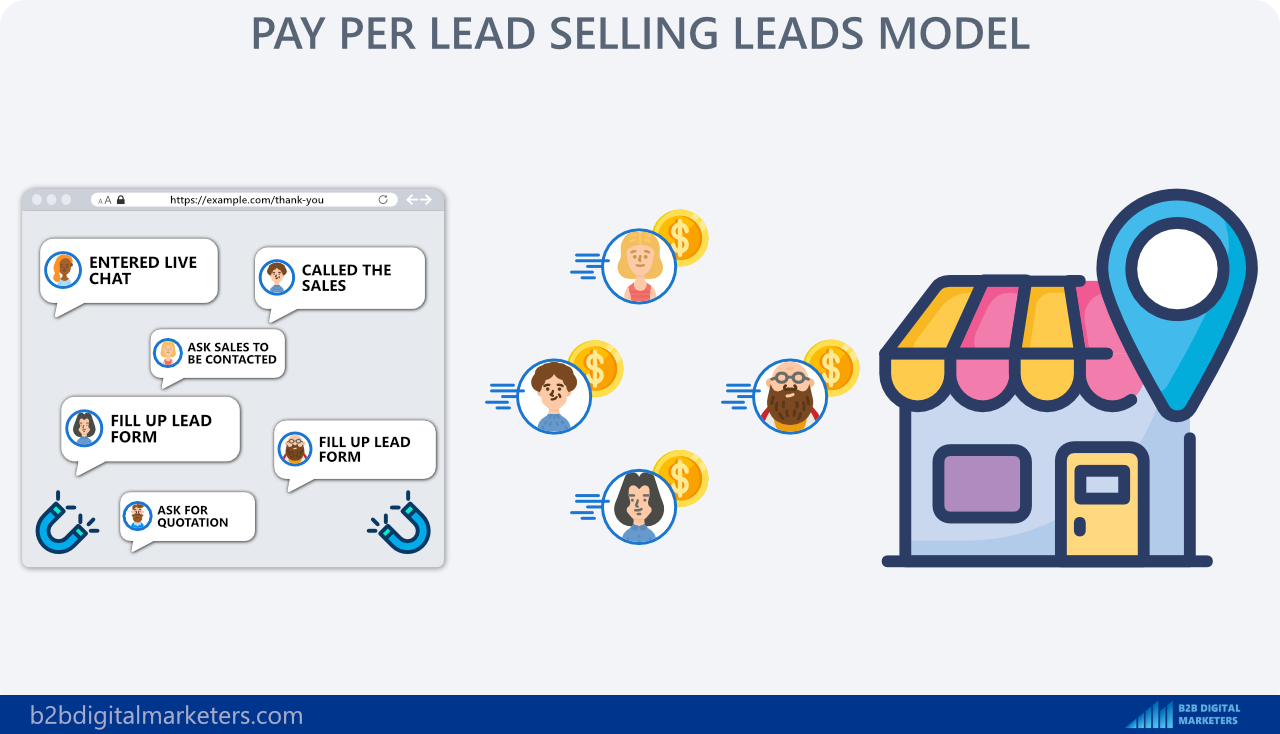
It’s arguably one of the most common ways of selling leads and is a straightforward model that benefits both the lead provider and the buyer. The lead provider only gets paid for the leads that they generate and provide, and the buyer gets a steady stream of potential customers without having to invest in lead generation themselves.
This model is commonly used in industries such as insurance, real estate, and financial services, where businesses rely heavily on lead generation to acquire new clients.
While the pay-per-lead model is simple and effective, you should ensure that you have a clear agreement with the buyer on what makes a qualified lead to avoid any payment disputes.
Additionally, the buyer may set specific criteria for the types of leads they are looking for, which can impact the volume and quality of leads that you can generate, so it’s really important that both of you find common ground on this and write it down.
Way #2: Monthly Fee/Retainers
The second way to sell leads is by receiving monthly fees/retainers from businesses or brokers.
Basically, you will be renting out your website and services to the business for a monthly fee and providing all the leads you generate.
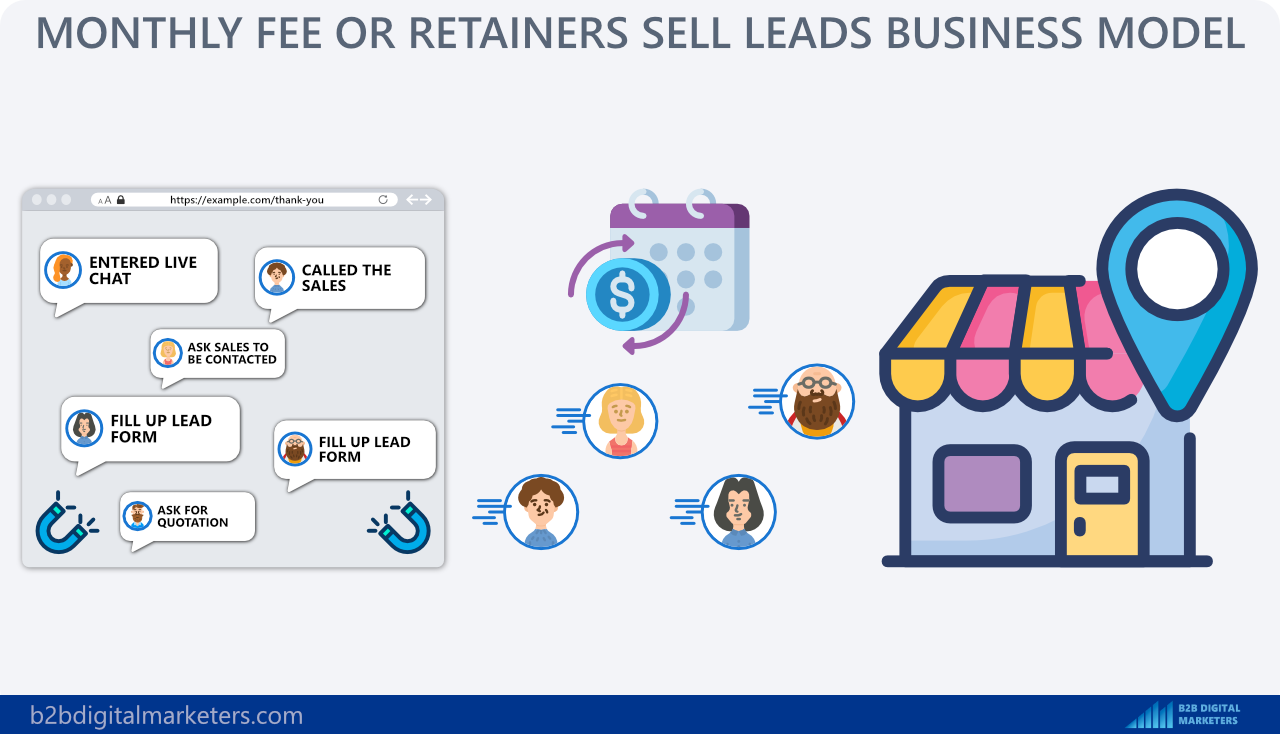
This can be a more secure way to run a business as you get steady and reliable payments, and you won’t be subjected to any fluctuations. But on the other hand, during high demand, you will not generate high profit as you would with pay-per-leads.
This model can be especially useful for businesses that have a high-volume and steady demand for leads, such as B2B companies or those in a certain service industry.
And again, you should have an agreed contract with the buyer about the quality and quantity of leads expected and what will happen if you do not deliver or over-deliver.
Way #3: Commission Deal
The third way how you can sell leads is by the commission deal model. This model is similar to the pay-per-lead model, but instead of a flat fee, you would receive a commission for every lead that results in a sale for the buyer.

This model is the most beneficial to both sides as only those leads that convert will provide revenue for both sides resulting in both sides working towards improving quality leads and getting as many leads as possible to close.
However, the downside of this strategy is that you need to choose a company that can handle a large number of sales in case of high demand, so leads don’t get wasted.
Also, it’s hard to create a structure where you can see exactly what leads closed and how much commission you earned from each one. This can make it challenging to track your earnings and optimize your lead generation strategy and significant trust is required from your side to your partner.
Way #4: Sell the Website
The fourth way how you can sell leads is by actually selling the lead generation website.
Instead of selling individual leads, you can sell the entire website to a business or broker who is interested in acquiring an existing lead generation business.
This strategy provides you with a high-value exit strategy as a website worth is somewhere between 30 to 50 times its monthly revenue.
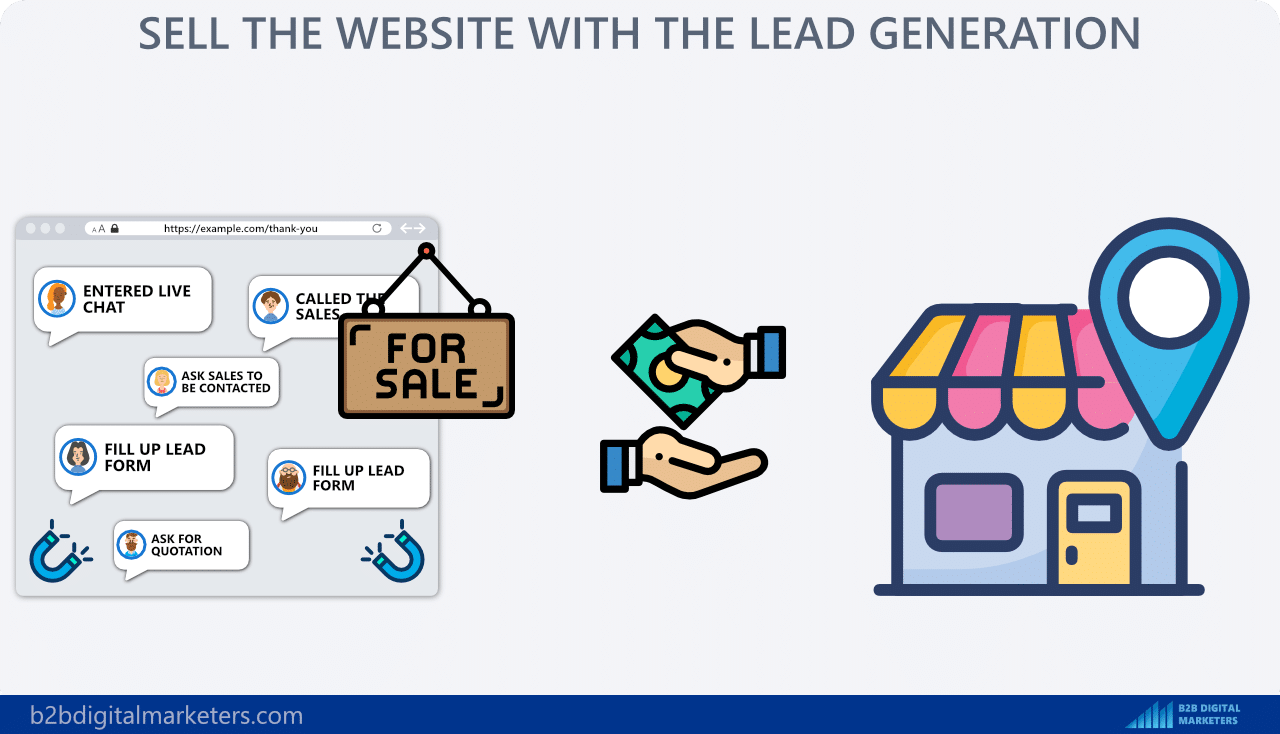
Now, calculating the website’s monthly revenue for a lead generation website is harder compared to SaaS, ad revenue, or affiliate-based website as there the monthly revenue is pretty clear.
With a lead generation website, the revenue is relative.
However, it is possible to arrive at a good price for the website by estimating the revenue based on the number of leads generated and the price per lead and multiplying that figure by 30-50x. This can provide you with a fair price for the website while ensuring the buyer receives a good return on their investment.
For example, if your price per lead is $50 and you generate on average 50 leads a month, based on the past 6-12 months, you should be able to sell your website for around $75,000-$125,000.
Way #5: Become a Provider
And the very last way how you can sell leads is by actually becoming the provider yourself.
For example, if you are selling roofing or plumbing leads in Richmond, Virginia, then what is stopping you to create your own company, hire a few professionals and start providing plumbing or roofing services yourself?
Through this, you will generate the leads for your own company maximizing the profit potential and taking control of the entire process, from generating the leads to providing the services to customers.
However, becoming a provider can be a bit more challenging than simply selling leads, as it requires you to have expertise in the industry and the ability to provide high-quality services to customers.
In addition to generating leads for your own company, you can also sell any excess leads to other companies in your industry, which can help offset the costs of lead generation and increase your profits.
Overall, becoming a provider can be a great way to monetize your lead generation efforts and take your business to the next level.
FAQs: Selling Leads
Yes, you can sell leads to multiple clients, but you need to be transparent about it. You should disclose that the leads are not exclusive and may have been sold to other clients. You can also consider segmenting your leads by industry or location to provide more targeted leads to your clients. Additionally, it’s important to have a clear agreement with your clients that outlines the terms of the lead sale, including any guarantees, refunds, or replacements in case the leads are not of satisfactory quality.
Companies buy leads as a way to generate new business opportunities and increase revenue. By purchasing leads, companies can reach potential customers who have already expressed interest in their products or services.
Buying leads can also save time and resources that would otherwise be spent on finding and qualifying leads on their own. Additionally, purchasing leads can provide access to a broader range of leads, including those outside of their typical marketing channels. Overall, buying leads can be an effective way for companies to expand their customer base and increase their chances of making a sale.
The cost of leads can vary depending on factors such as the industry, the quality of the leads, and the type of leads. Generally, leads can sell for anywhere from a few cents to several dollars per lead. For example, leads for consumer goods or services may sell for a lower price compared to B2B leads, which typically sell for a higher price due to their higher value.
The cost of leads may also be influenced by the way they are generated, such as through digital marketing campaigns or through traditional advertising channels. Ultimately, the cost of leads is determined by supply and demand in the market, so it’s important to research and compare prices to ensure you are getting a fair price for your leads.
Yes, you can make money selling leads. Lead generation can be a profitable business model, particularly if you have expertise in a specific industry or niche. By generating leads and selling them to companies, you can earn a commission for each lead sold.
The amount you can earn per lead will depend on various factors such as the quality of the lead, the demand for leads in your niche, and the price you charge for each lead. To be successful in selling leads, it’s important to have a reliable lead generation process, a solid network of potential buyers, and a good understanding of the market and the needs of your customers.
Yes, it is legal to sell leads as long as the leads were obtained ethically and with the consent of the individuals involved. However, there are laws and regulations, such as the CAN-SPAM Act and GDPR, that govern the collection, storage, and use of personal data. It’s important to ensure that your lead generation practices comply with these laws and that you are transparent about how you collect and use the data. Additionally, it’s important to have clear terms of service and privacy policies to protect both your business and your customers.
Related Articles:
- Best 11 SpyFu Alternatives in 2023 (Paid & Free)
- 7 Best Copy AI Alternatives (Free & Paid)
- Best 10 Screaming Frog Alternatives in 2023 [Free & Paid]
- How Long Does It Take to Learn SEO?
- How to Generate Sales Leads without Cold Calling
- SaaS Lead Generation for B2B & B2C: 14 Proven Strategies, Tips & Best Practices
Also, check out our SEO hub page to find all our SEO resources.
Disclaimer
This article was created by Eduard Dziak and may contain affiliate links. The following were used to optimize the article for the best user and search engine experience include:
- SE Ranking for keyword research and on-page SEO optimization
- Surfer SEO for SEO-friendly content creation for users and search engines.
- Jasper AI for grammar correction and information enhancement.
The article is based on the author’s own experience and knowledge, drawn from both their own work and that of their clients, to provide the latest, proven methods.
Support the B2BDigitalMarketers
Hey, Eduard here.
As a solo blogger with limited resources, I need your support to keep creating in-depth SEO content like this. Please consider joining my Patreon community to help this site grow.
Your pledge – no matter how small – will enable me to dedicate more time to sharing actionable tips and strategies. With your help, I can take this project to the next level and really make a difference for other SEOs and marketers.
I would sincerely appreciate you joining me on this journey as a founding patron. Together, we can build an amazing resource hub. Hope to see you on the inside – thanks for your trust and support!

